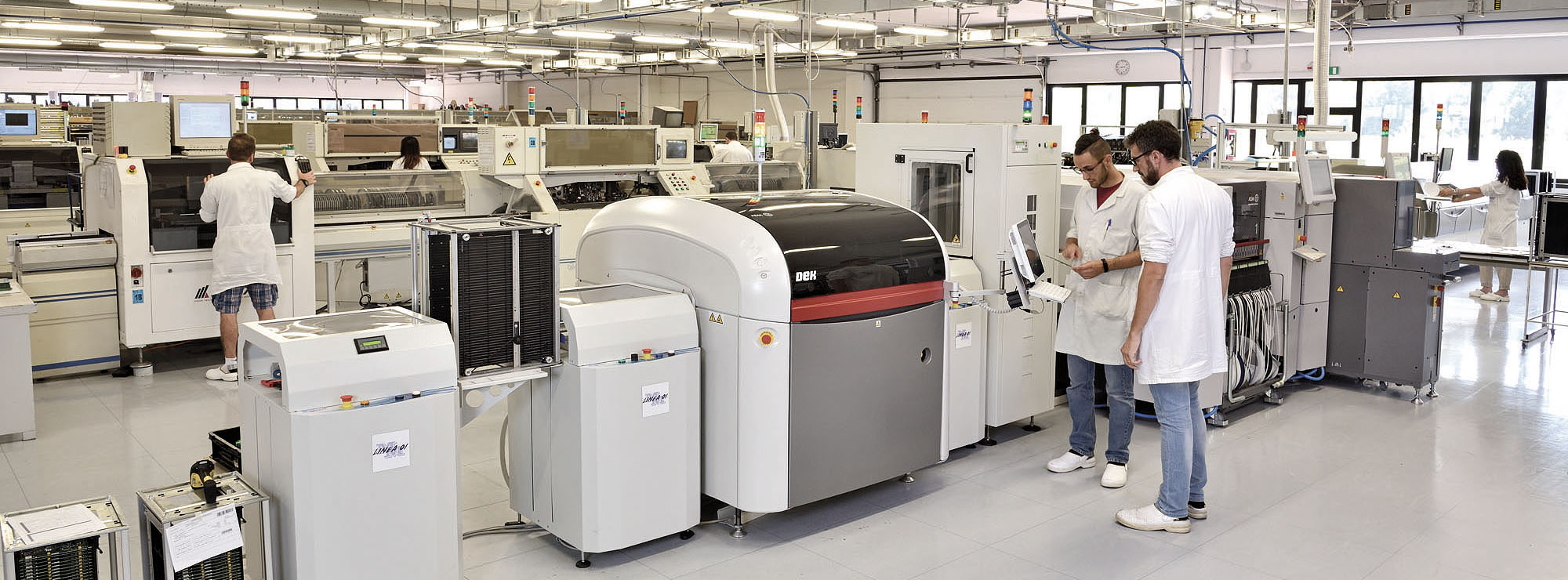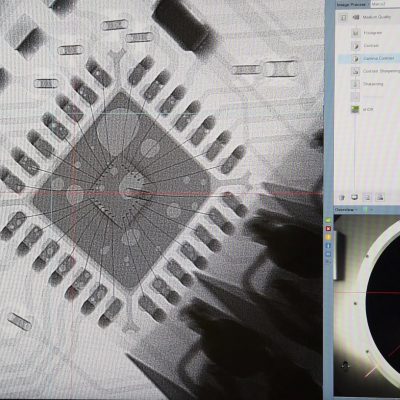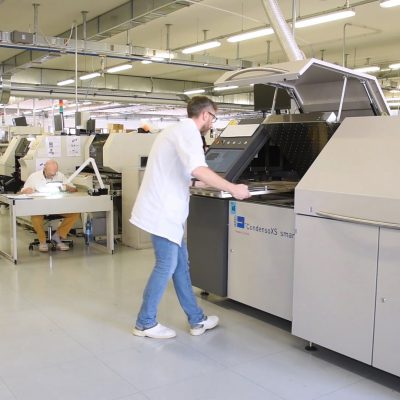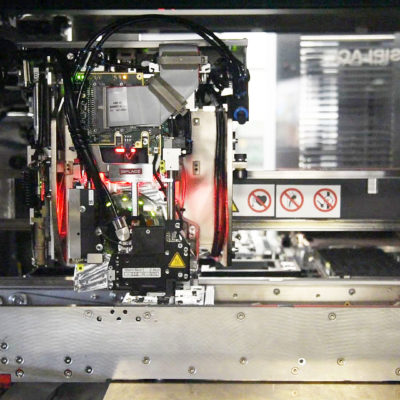
SERVICES & EQUIPMENT
MICRO MEGA assembles printed circuits for important domestic and foreign brands thanks to 15-year experience, has a modern and performant warehouse and a team of skilled and cooperative technicians. All of this is characterized by prompt and high quality service also for small and medium-size batches.
MICRO MEGA completes its offer combining a number of services aiming at giving technical/organizational and engineering support like prototype assembly, production of small and/or urgent batches and the possibility to assist Customers with items either as contract work or as purchase account and deliveries through its own vans.
EQUIPMENT
The equipment installed at MICRO MEGA is the most advanced technological answer to customer’s requests.
Among SMT lines, high speed ASM Siplace stands out and overall performances reach levels that were unthinkable in the past. These lines are integrated with forced air reflow ovens, double wave welder compatible with lead-free alloys, equipped with systems of spray flux and welding in inert medium (nitrogen), a double wave welder to weld products still to assemble by means of tin/lead technologies and a new system of conformal coating.
A specific department is dedicated to the visual control stations, through both screen control and microscope, and another one is destined to functional testing and in-circuit by means of mobile probes and bed of nails.
MICRO MEGA is equipped with a rework Weller WQB4000SOPS to rework BGA and QPF. Here all rework activities on particularly complex components (BGA, QPP, QFN, etc.) are carried out.
PRODUCTS
Assembling lines that allow to assemble all types of passive and active components, through automatic processes of screen printing, glue distribution, assembly, new fusion in inert atmosphere and polymerization:
- Passive (01005 – 0201 – 0402 – 0603 – 0805 – 1206 – fino a 55mm²)
- Active (BGA – µBGA – CSP – QFP – SSOP…)
- Oddshape (Transformers, Connectors, SMT, …)
Assembling of PTH components (axial, radial and e dip) on equipped lines.
Storage Department
Electronic components are properly coded and placed in locations having appropriate anti-static characteristics. The warehouse is divided into coded areas. Customized corners can be reserved for each single Client, if components are given as contract work by this latter. All the items (stored materials, components to work and similar) are managed by a central information system.
All MSD components are properly vacuum-sealed and controlled until the assembly phase.


Smt Department
5 assembling lines that allow to assemble all types of passive and active components, through automatic processes of screen printing, assembly, new fusion in inert atmosphere or polymerization.
AOI for automatic optical control
Automatic visual inspection for optical control of medium and big-size batches.
Pick and Place ASM
Two ASM Pick and Place with smart feeder allow a quicker production that is easily adjustable to match the widest requests. Siplace SX of ASM is the first machine with full gantry modularity technology. This eliminates the expensive reconfigurations of the old SMT lines, increases speediness during components assembly and improves operation quality. In the meanwhile, the two machines replaced were moved to a smaller line that is destined to small series and prototypes. Thus, productivity is enhanced and today, like for the other lines, a full tracking of each component becomes possible.
With three assembly lines equipped with the best ASM machines, we can assemble both high miniaturization components and big BGA and connectors “pin in paste” (THR), with a capacity of over 120 million components per year, and growing more and more.
Welding Department
Vacuum Vapor Phase welding
The “Vapor Phase” or “ Steam Condensation ” welding technology uses for the board heating process, the thermal energy emitted by the change of state of a fluid inert (GaldenTM LS / HS) which creates a “vapor zone”, where the assembled board, after a preheating phase, stays for the foreseen time, to be welded in extremely uniform conditions.
The thermal transfer between the steam and the assembled board occurs during the condensation phase, which remains until the temperature of the steam itself is reached on the surface of the board.
The association of the Vapor Phase welding process with the “Chamber Vacuum” concept favors the reliability of the product, with a reduction in voids and therefore greater mechanical reliability for the BGA components and greater heat transfer for the power components.
Since the vapor temperature is directly correlated to the boiling temperature of the inert fluid, the operating conditions in which the printed circuits and electronic components are managed is that of maximum control and safety, precisely because the maximum operating temperature is defined by the principles physical related to the type of fluid used.
The result is a welding process without oxidation, with thermal transfer significantly superior to convection or radiation ovens and an irrelevant thermal differential between components of different sizes.
& nbsp;
Wave welding
- 1 double wave welder with RoHS alloy, equipped with spray fluxing systems and welding in an inert environment (nitrogen).
- 1 double wave welder for welding of products still assembled with Tin / Lead technology
& nbsp;
Selective welding in an inert atmosphere
- 2 ERSA VERSA FLOW selective welding lines 3/45 including automatic loading and unloading modules, equipped with multiple wells, for Lead-Free and Tin / Lead alloys. prepared with a lower and upper preheating system to maintain the temperature during the welding phase and one of the two can manage “miniwave” welding.
All MSD components are properly sealed under vacuum and monitored until the assembly phase.
AOI for automatic optical control
The Automatic Optical Inspection temporally follows the SMT assembly process of the boards, of which it intends to verify the absolute integrity of any assembly or welding defects. By preceding the electrical test and any functional testing, the AOI allows you to preliminarily identify possible defects that affect the functionality of the assembled board.
The Saki BF-3Di system allows the assembled boards to be inspected at “high speed”, providing the repairer with an objective analysis of the assembly quality of an electronic board: in fact, the implementation of 3D technology has revolutionized the way to analyze the PCBA, reducing the false error calls and the subjectivity of the operator in the analysis, since images are not evaluated by comparison, but a real measurement is provided in the three spatial dimensions.

X-ray Inspection
Given the increasing complexity of electronic boards, with BGA, QFN or LGA, in which the connections by brazing are no longer visible by microscope inspection and where the classic AOI inspection proves insufficient, it is indispensable X-ray inspection to verify the welding compliance of the products.
The advantage of X-rays is to be able to carry out a non-destructive inspection thanks to the emission of high-frequency electromagnetic radiation consisting of photons.
In the image, the dense elements absorb photons and appear in black, the less dense elements are instead crossed by photons and appear more transparent.
Washing Department
Upon specific request by the Client or if this is necessary to eliminate any flux residues from the board, the following items are available:
- A new washing system PBT Works is highly performant and eliminates all the unwanted contaminations that are present in the electronic production and in micro-mechanical processes. The elimination of resin and flux residues avoids corrosion that can lead to dispersion and short-circuits over time. A proper cleaning with a perfect washing process improves significantly the insulation resistance of the surface (SIR) – this is an important factor to increase reliability of electronics in difficult environments.
- 1 washing line composed of one washing machine (water) with drying oven and controlled temperature
- 1 washing machine MIELE IR 6002 (water+Vigon) to wash water-insoluble fluxes and then to dry the products with no additional handling of the boards (passage to oven).
Testing Department
After the visual examination of all the products assembled, “In-circuit” parametric tests can be carried out through mobile probes or bed of nails. Then, proper functional tests with client interface can be carried out. Upon completion of all activities, the relevant compliance certificate is issued.
BGA/QFP Rework
Micro Mega is equipped with a rework Weller WQB4000SOPS station to rework BGA and QPF.
Here all rework activities on particularly complex components (BGA, QPP, QFN, etc.) are carried out.
The machine used is equipped with a double camera allowing the best optical alignment during the re-positioning phase of the component on the printed circuit.
The station has entries for K probes to obtain proper cycle profiles.
Altri servizi
MICRO MEGA è fortemente orientata a fornire ai propri Clienti anche un servizio a supporto dei prodotti realizzati:
- Montaggio prototipi (il plus della nostra azienda);
- Lotti di produzione da poche unità a quantità consistenti;
- Tempi di consegna ridotti per forniture “urgenti”;
- Fornitura di materiale in parziale conto lavoro e conto acquisto o totale conto acquisto (componenti elettronici, meccanici, ecc.);
- Trasporti con corrieri veloci ed affidabili;
- Supporto tecnico/organizzativo ed ingegneristico per l’assemblaggio elettro-meccanico.






































